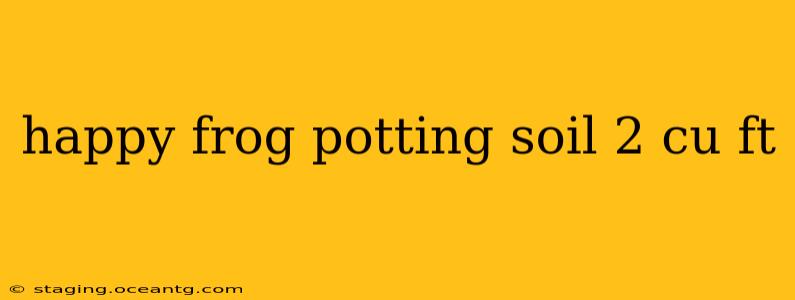Happy Frog Potting Soil has become a favorite among home gardeners and professional growers alike. Its popularity stems from a reputation for quality ingredients and consistent performance, making it a top choice for various plants. This in-depth guide explores the 2 cubic foot bag of Happy Frog Potting Soil, examining its features, benefits, and best uses. We'll also address frequently asked questions to ensure you have all the information you need to make an informed decision.
What Makes Happy Frog Potting Soil Unique?
Happy Frog distinguishes itself from other potting mixes through its focus on organic ingredients and a blend designed for optimal plant growth. The 2 cubic foot bag provides a substantial amount of soil, ideal for larger containers or multiple planting projects. Key components typically include:
- High-quality peat moss: Provides excellent aeration and water retention.
- Compost: Adds essential nutrients and beneficial microbes.
- Worm castings: Rich in nutrients and improve soil structure.
- Mycorrhizae: Beneficial fungi that enhance nutrient uptake by plant roots.
This combination creates a loose, well-draining mix that's rich in organic matter, supporting healthy root development and vigorous plant growth. The absence of harsh chemicals also makes it a safe choice for organic gardening practices.
Is Happy Frog Potting Soil Good for Seed Starting?
Yes, Happy Frog Potting Soil is well-suited for seed starting. Its fine texture and excellent drainage prevent seeds from rotting, while the rich nutrient content provides a good foundation for seedling growth. However, some gardeners prefer to use a seed-starting mix specifically designed for its finer texture and lower nutrient content to avoid burning delicate seedlings. Many choose to transplant seedlings into Happy Frog potting mix later in their growth.
What Type of Plants Does Happy Frog Potting Soil Work Best For?
Happy Frog Potting Soil is versatile and suitable for a wide range of plants, including:
- Vegetables: Tomatoes, peppers, cucumbers, and leafy greens all thrive in this nutrient-rich soil.
- Flowers: Annuals, perennials, and herbs benefit from the excellent drainage and aeration.
- Houseplants: Many indoor plants appreciate the loose texture and organic composition.
However, it's important to note that like any potting mix, Happy Frog might need supplementing with additional nutrients as your plants grow, especially for heavy feeders.
How Long Does a 2 Cubic Foot Bag of Happy Frog Potting Soil Last?
The longevity of a 2 cubic foot bag depends entirely on the size of your containers and the number of plants you're growing. A single bag can easily handle several large container plants or numerous smaller pots. For larger-scale gardening projects or those with numerous plants, multiple bags might be necessary.
Is Happy Frog Potting Soil Worth the Price?
While Happy Frog Potting Soil is generally considered a premium product, many gardeners feel the cost is justified by the quality of the ingredients and the resulting plant growth. The improved plant health often translates to a better yield and healthier plants overall, making the investment worthwhile for many. Comparing prices across different retailers is always recommended.
Happy Frog Potting Soil vs. Other Brands: What's the Difference?
Numerous potting soil brands exist, each with its unique blend of ingredients and properties. While a direct comparison depends on the specific competing brand, Happy Frog generally emphasizes organic ingredients and a focus on promoting healthy root development. Some other brands may prioritize cost-effectiveness or specific nutrient profiles, tailoring their blends to particular plant types. Choosing the best potting soil ultimately depends on your specific gardening needs and preferences.
This comprehensive guide provides a detailed look at Happy Frog Potting Soil's 2 cubic foot bag. Remember to always check the product label for the most up-to-date information on ingredients and usage instructions. Happy gardening!
